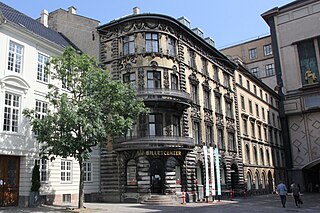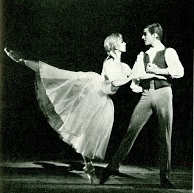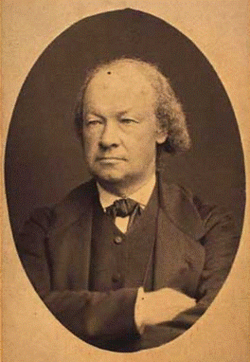
The Royal Danish Ballet is an internationally renowned classical ballet company, based at the Royal Danish Theatre in Kongens Nytorv, Copenhagen, Denmark. It is one of the oldest ballet companies in the world and originates from 1748, when the Royal Danish Theatre was founded. It was finally organized in 1771 in response to the great popularity of French and Italian styles of dance. The company was founded with the opening of the Royal Danish Theatre, which has served as its home since that time. The Royal Danish Ballet school was founded in 1771 under the leadership of French ballet teacher Pierre Laurent (1730–1807), then Vincenzo Galeotti developed it and August Bournonville founded his methodology for the school.
Museum Odense is a self-governing museum institution in Odense, Denmark.
The Danish Golden Age covers a period of exceptional creative production in Denmark, especially during the first half of the 19th century. Although Copenhagen had suffered from fires, bombardment and national bankruptcy, the arts took on a new period of creativity catalysed by Romanticism from Germany. The period is probably most commonly associated with the Golden Age of Danish Painting from 1800 to around 1850 which encompasses the work of Christoffer Wilhelm Eckersberg and his students, including Wilhelm Bendz, Christen Købke, Martinus Rørbye, Constantin Hansen and Wilhelm Marstrand, as well as the sculpture of Bertel Thorvaldsen.

Napoli, or The Fisherman and His Bride is a ballet created in 1842 for Denmark's Royal Ballet by Danish choreographer and ballet master August Bournonville. It tells the story of Teresina, a young Italian girl who falls in love with Gennaro, a fisherman, and culminates in the marriage of the lovers.

Johan Peter Emilius Hartmann was, together with his son-in-law Niels W. Gade, the leading Danish composer of the 19th century, a period known as the Danish Golden Age. According to Alfred Einstein, he was "the real founder of the Romantic movement in Denmark and even in all Scandinavia". J.P.E. Hartmann was the third generation of composers in the Danish musical Hartmann family.

Johannes Volf Møllehave was a Danish Lutheran priest, author, and lecturer.

A Folk Tale is a ballet in three acts, created in 1854 for the Royal Danish Ballet by the Danish ballet master and choreographer August Bournonville to the music of Johan Peter Emilius Hartmann and Niels W. Gade. The first performance took place on 20 March 1854. Set in the Middle Ages, the ballet tells the story of a changeling living among the trolls and elves. Bournonville declared the ballet "The most complete and best of all my choreographic works."

Emil Hartmann was a Danish composer of the romantic period, fourth generation of composers in the Danish Hartmann musical family.

Maria Charlotta Westberg, was a Swedish ballerina.
Events from the year 1805 in Denmark.
Events from the year 1797 in Denmark.
Frank Andersen is a former Danish ballet dancer who was twice artistic director of the Royal Danish Ballet. He has been an influential supporter of the Danish choreographer August Bournonville.

Dinna Bjørn is a Danish ballet dancer and choreographer. She has specialized dancing and directing the ballets of August Bournonville. Bjørn has also created five Hans Christian Andersen ballets for the Pantomime Theatre in Copenhagen's Tivoli.

Brønnum House is a richly decorated 1860s apartment building situated adjacent to the Toyal Danish Theatre's Stærekassen extension and the Harsdorff House on Kongens Nytorv in central Copenhagen, Denmark. It was constructed as one of the first new buildings when the former Gammelholm naval dockyards was transformed into a new residential neighborhood. Café Brønnum, frequented by actors from the adjacent theatre, was based in the building for more than 100 years. The homes of the wealthy Jewish businessman Martin Henriques and Bernhard Hirschsrpung on the first and second floor were both frequented by some of the leading cultural figures of their time. The building was listed in the Danish registry of protected buildings and places in 1995. The building is now owned by Karberghus. It houses a high-end cocktail bar on the ground floor and serviced offices on the upper floors.

Carl Christian Møller was a Danish concertmaster and composer. His father was a musician and early in his life Carl Christian was hired in the Danish Civil Artillery Music Corps and later became a musician in the 2nd Brigade Music Corps while also playing in Hans Christian Lumbye's orchestra. He participated in the First Schleswig War as a musician but from the 1850s and the rest of his life he worked as leader of different orchestras, initially travelling ensembles but in 1857-64 and 1875-85 he led the orchestra of Folketeatrets in Copenhagen. From 1875 until his death he was a popular leader of Tivoli's concert band.

Betty Mathilde Hennings née Schnell (1850–1939) was a Danish actress who entered the Royal Danish Theatre as a ballet dancer but in 1870 turned to acting, first performing in Molière's The School for Wives. She later became known for her roles in the plays of Henrik Ibsen, especially as Nora in A Doll's House.

Marcus Ruben Henriques, commonly known as Martin (R.) Henriques was a Jewish-Danish businessman. He was the father of the musician and editor Robert Henriques and the painter Marie Henriques.

Lise la Cour (1944–2016) was a Danish ballerina, choreographer and dance teacher. After training at the company's ballet school, she premièred at the Royal Danish Ballet in 1961 and went on to star in a series of ballets including Bournonville's Napoli, Balanchine's The Four Temperaments and Flemming Flindt's The Young Man Must Marry. From the late 1970s, she was principally a choreographer, creating ballets based on the fairy tales of Hans Christian Andersen's, starting with Hyrdinden og skorstensfejeren in 1988. She was Viceballetmester of the Royal Danish Ballet from 1988-1995 and was involved in several large theatre productions in the following years until she was appointed Administrative Director of the Royal Danish Opera from 1999 to 2001, ensuring a smooth transition between the former opera director Elaine Padmore and newcomer Kasper Holten. In 2002, she moved to San Jose, California, where she was appointed school director of the Ballet San Jose until she established her own school, Lise la Cour's LaCademy of Ballet, in 2012.













